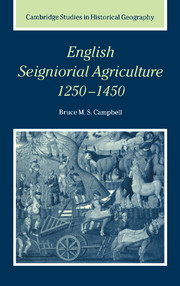Book contents
- Frontmatter
- Contents
- List of figures
- List of tables
- Preface and acknowledgements
- Abbreviations
- Weights, measures, values, and boundaries
- 1 Introduction: agriculture and the late-medieval English economy
- 2 Sources, databases, and typologies
- 3 The scale and composition of the seigniorial sector
- 4 Seigniorial pastoral production
- 5 Seigniorial arable production
- 6 Crop specialisation and cropping systems
- 7 Arable productivity
- 8 Grain output and population: a conundrum
- 9 Adapting to change: English seigniorial agriculture 1250–1450
- Appendix 1 Demesne-level classification of husbandry types
- Appendix 2 Demesnes represented in the Norfolk accounts database
- Appendix 3 Demesnes represented in the FTC accounts databases
- Consolidated bibliography
- Index
- Cambridge Studies in Historical Geography
9 - Adapting to change: English seigniorial agriculture 1250–1450
Published online by Cambridge University Press: 20 October 2009
- Frontmatter
- Contents
- List of figures
- List of tables
- Preface and acknowledgements
- Abbreviations
- Weights, measures, values, and boundaries
- 1 Introduction: agriculture and the late-medieval English economy
- 2 Sources, databases, and typologies
- 3 The scale and composition of the seigniorial sector
- 4 Seigniorial pastoral production
- 5 Seigniorial arable production
- 6 Crop specialisation and cropping systems
- 7 Arable productivity
- 8 Grain output and population: a conundrum
- 9 Adapting to change: English seigniorial agriculture 1250–1450
- Appendix 1 Demesne-level classification of husbandry types
- Appendix 2 Demesnes represented in the Norfolk accounts database
- Appendix 3 Demesnes represented in the FTC accounts databases
- Consolidated bibliography
- Index
- Cambridge Studies in Historical Geography
Summary
Agriculture before the Black Death: constraints versus incentives
On the evidence of the seigniorial sector English agriculture c. 1300 presents a paradox. High prices and low real wages coupled with the great physical extent of the agricultural area, strong arable bias to production, growing emphasis upon grains with high food-extraction rates, and impressive value of agriculturally based exports all imply that agriculture was operating at full stretch, yet only limited advantage was taken of the productivity gains which more intensive and innovative forms of husbandry and modes of land-use were capable of delivering. Across the greater part of the country the intensive extremes of coppiced woodland, closely regulated meadows, enclosed grassland, and more or less continuously cropped arable remained the exception rather than the rule. Instead, the predominance of low unit land values indicates that comparatively extensive methods of managing woodland, grassland and arable remained the norm (Table 9.01 and Figure 9.01). Of sampled demesnes, almost 40 per cent practised the more extensive forms of arable husbandry (Table 6.01 and Figures 6.05, 6.06, and 6.07), over 60 per cent the more extensive forms of pastoral husbandry (Table 4.01 and Figures 4.08 and 4.10), and approximately 50 per cent the more extensive forms of mixed husbandry (Table 4.08). Throughout the south, centre, west, and north of the country seigniorial land-use and husbandry remained less differentiated and technologically progressive than in the east midlands, East Anglia, and south-east. The sheer geographical extent of these agriculturally least developed parts of the country lends weight to G. Astill and A. Grant's verdict that ‘we are left with a slightly depressing picture of medieval agricultural progress and productivity, which suggests that opportunities for improvement may have existed but were not taken up’.
- Type
- Chapter
- Information
- English Seigniorial Agriculture, 1250–1450 , pp. 411 - 440Publisher: Cambridge University PressPrint publication year: 2000

